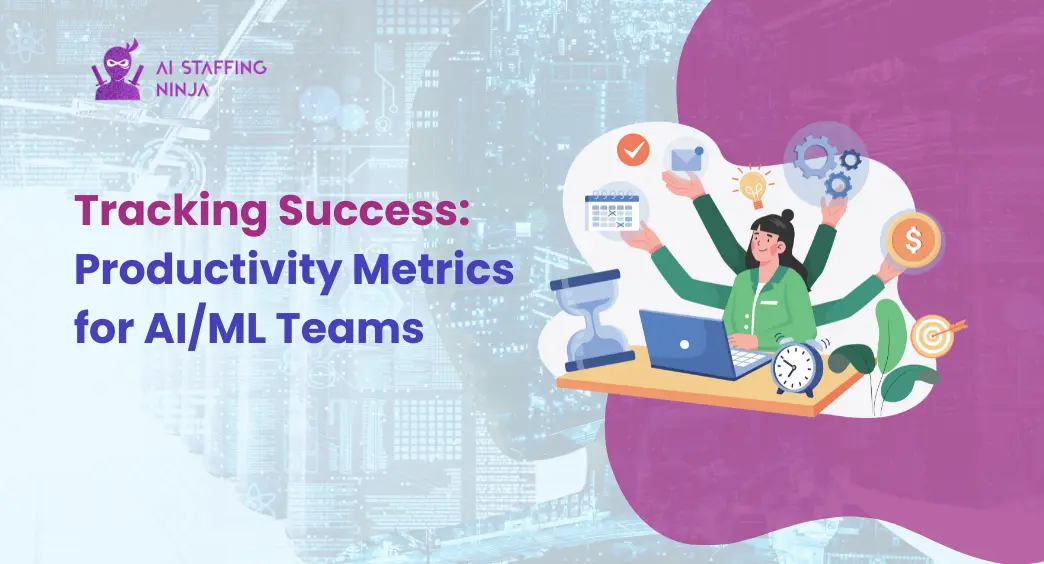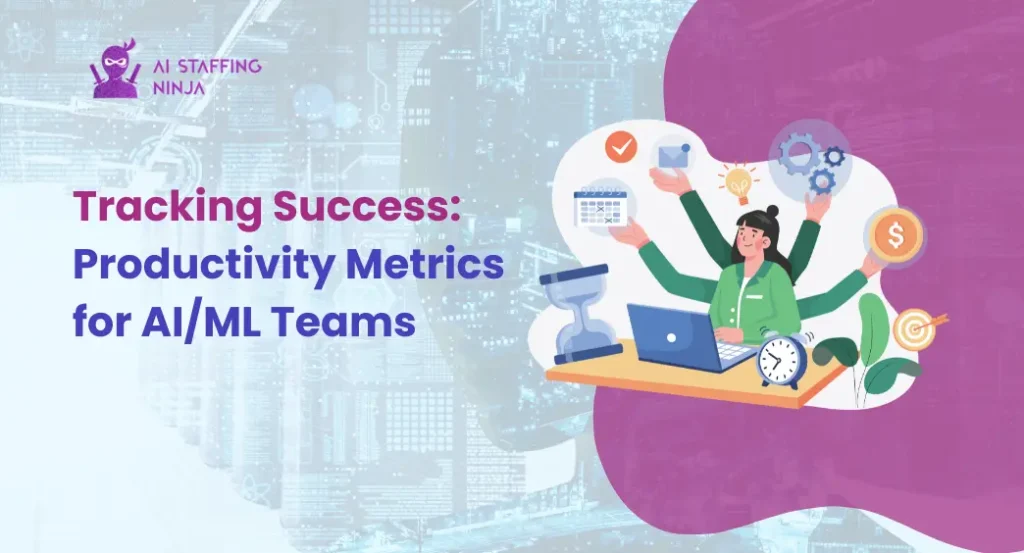
- By : By Staffing Ninja
Essential Metrics to Track Workforce Productivity in AI/ML Teams

Studies and statistics manifest a marked productivity hike in AI business and the tangible potential to transform patient management in healthcare, which the productivity metrics impart progressively. These metrics spot the exact potential problems and abnormalities in organizational tasks through various parameters and assist in comprehending the team’s efficiency, the project’s progression, and overall performance. This article solely sheds insight on the necessary AI team productivity metrics critical for effectively tracking and enhancing workforce productivity within AI/ML teams.
What Impacts Productivity in AI/ML Teams?
Key Factors That Influence Productivity: Productivity in AI/ML teams relies on numerous factors like:
- Teammates’ expertise level – Teams lacking in skill experience a decline in productivity due to a lack of technical expertise, while those with highly skilled members manifest remarkable productivity.
- Usage of data quality for model training – Usage of reliable data boosts productivity against vague and uncertain data.
- The efficiency of workflows and tools in the development process – Efficient tools and workflows uncover new boundaries, accelerate strategic focus, and reduce recurring activities and the time consumed analyzing huge data.
Challenges in Measuring AI/ML Productivity: Some familiar struggles in assessing productivity include setbacks in AI workforce efficiency, limitations in integrating with prevailing systems, heavy implementation expenses, long development cycle models, ethical and privacy concerns, debugging complex issues, and dependencies on data availability.
AI/ML Workflow Efficiency Metrics
Code Quality Metrics
A clean, well-structured, and sustainable code is essential for long-term success as it lowers the possibility of bugs and is much more reliable and secure. Comprehending such codes isn’t a hectic task and it directly impacts the overall software efficiency and performance.
Key Metrics to Track:
- Code complexity – The cyclomatic complexity indicates the ease of testing and maintenance by assessing the possible unrestrained paths through the code.
- Code churn – Code churn signifies the frequency of changes employed to the code over a stipulated timespan.
- Frequency of code reviews – Code review indicates going through the code line by line for any vulnerabilities, bugs, or breaches of quality norms. This can be done manually or automated.
How These Metrics Improve Productivity: Adhering to predefined consistent coding standards reduces technical debt, accelerates debugging, and facilitates collaboration.
Model Performance Metrics
Why Model Performance Matters: Imbalanced datasets find Model Performance Metrics quite crucial as the success of AI/ML teams depends on building accurate and efficient models.
Key Metrics to Track
- Accuracy, precision, recall, F1 score: Accuracy represents the proportion of exact predictions. Precision and recall find greater significance in imbalanced datasets. While precision is a measure of credible positives amidst all positive predictions, Recall signifies the percentage of genuine positives rightly identified. F1 signifies the agreeable mean value of precision and recall. It gives a balanced perception of both.
- ROC-AUC: The ROC (Receiver Operating Characteristic) Curve foresees exchange between accurate and inaccurate positive rates. On the other hand, AUC (Area under the curve) portrays the model’s comprehensive performance.
- Model drift: It monitors the performance of machine language over time due to variations in data or in the correlation between input and output variables.
How These Metrics Improve Productivity: Tracking these metrics portrays the precision parameters helping teams to fine-tune models productively. It further avoids deployment failures, which are otherwise costly.
System Performance Metrics
Why System Performance Affects Productivity: AI/ML models demand strong system infrastructure for smooth operation. This is because users hesitate to wait to receive replies and outputs and expect quick responses.
Key Metrics to Track:
- Latency – Latency refers to the response time to a user’s request, and it’s measured in milliseconds.
- GPU/CPU utilization – It marks the percentage of time the GPU/CPU was busy. This metric finds its significance in optimizing resource allocation.
- Uptime – This metric signifies the measure of availability of your application or business. It is essential to ensure that AI systems run with minimal downtime.
How These Metrics Improve Productivity: An AI/ML model with excellent system performance metrics empowers teams to spot and resolve issues quickly, reducing bottlenecks arising in model deployment. Rather than concentrating on one metric, a combination of all the system performance metrics, when used, the inference together provides a holistic evaluation.
Project Management Metrics
Why Project Management is Crucial for AI/ML Teams: AI projects are complex, requiring structured workflows and hence. These metrics assist project managers in tracking and measuring their project’s performance, assisting them in making data-driven decisions pertaining to practical changes and further developments.
Key Metrics to Track
- Sprint velocity – This metric refers to the number of tasks completed per sprint. Using this metric, managers allot the number of tasks their team can potentially accomplish within the deadline.
- Task completion rate – It is the measure of the percentage of finished tasks within a specific project. It gives details on task progression, assists in identifying bottlenecks, and guarantees timely completion of tasks.
- Throughput – It is a measure of the number of models or features completed and delivered within a stipulated time span.
How These Metrics Improve Productivity: Tracking these metrics eases the team lead’s burden of managing workloads, optimizing efficiency, and ensuring timely project delivery.
Collaboration and Communication Metrics
Why Collaboration is Critical in AI/ML Teams: AI projects involve various teams and hence require cross-functional collaborative teamwork. Tracking collaboration metrics employed by AI staffing solutions increases productivity, assists in setting clear targets, encourages personal accountability, and brings consciousness about financial boundaries.
Key Metrics to Track
- Code review participation – This metric tracks team engagement and collaboration during the review processes.
- Meeting effectiveness – It is a measure of how the meeting aligns with its objectives, minimizes time wasted, and enhances teammates to complete the essential tasks.
- Usage of collaboration tools – Tools like Slack, Jira, and GitHub activity clarify tasks and team accountability, simplify communication, and manage resources systematically.
How These Metrics Improve Productivity: The stronger the communication, the swifter the problem-solving with incredibly lower project delays. Also, tracking these metrics outlines to leaders on areas in the different teams that need improvement.
Wrapping Up
By tracking productivity metrics in AI/ML teams, the team’s efficiency boosts up, you comprehend their strengths and weaknesses, and the inferred clear insights assist in enhancing workflows thereby achieving better results. It also assists in streamlining processes, lowers errors, and ensures your project is on the right track. Getting in touch with an eminent AI recruitment agency offers great help in finding skilled AI/ML talent to improve team productivity.